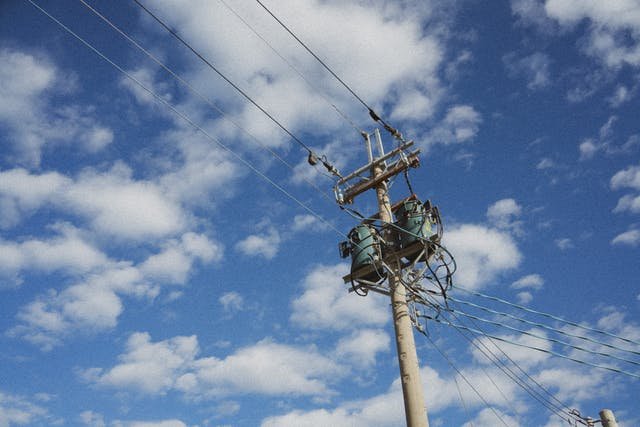Electrical Engineering - Powering the Humanity - Steemkidss Engineering Course Introduction, Season 1: Tutorial 4 by @cryptogecko

Namaste Steem Family, and my greetings to all my students who attend my lessons.
During the last lesson, you learned about the Mechanical engineering branch of engineering, which has had a huge impact on human history since its creation. Today, we are going to cover the electrical branch of engineering in this lesson. Now let us get started.
Introduction
In this day and age, electricity is an essential part of our lives and we would be unable to imagine life without it.
As a society, we are heavily reliant on electricity, magnetism, and other electronic components. As a field devoted to harnessing the power of electricity, magnetism, and other electronic components, electrical engineering focuses on the use of electricity and electromagnetism in our daily lives. The blood that flows through your veins powers the inner workings of your body. In the same way, electrical power flows through the wires, sending pulses that enable the systems around you to function.
The existence of this resource is absolutely essential to our survival. As a matter of fact, I would even go so far as to state that it serves as the lifeline of our society. Among the branches of electrical engineering, there are three fundamental branches that make up three of the most important elements of our society at the present time. They are: telecommunications, computer engineering, and power & lighting. Their individual journeys have been marked by challenges, victories, heroes, and occasionally villains along the way, and each has come to be in their own way.
Throughout the history of electrical engineering, you would be shocked to discover the number of deaths that have occurred at various times. Because electrical engineering is a field that can be extremely dangerous, as you may already know.
Electricity & Magnetism
Electrical engineering includes two fundamental elements, electricity and magnetism. Therefore, it is reasonable to assume that the field would not exist until these things were understood.
There was no clear explanation of how magnets worked in electromagnetism in the early days of electromagnetism. In 1600, William Gilbert, an English physicist who wrote a major work on magnetism, De Magnete, described this phenomenon in a more accurate manner. His experiments over several years eventually led him to prove that the compass needle points north and south and dips downward. Earth's natural magnetism is responsible for this phenomenon. It is widely considered that he was the first to describe the phenomenon of electrical attraction and magnetic poles. This is one of the reasons why many consider him to be the father of electrical engineering.

Electrical conduction was discovered by a British scientist - Stephen Gray - around 1729, which occurs when electrically charged particles transfer energy through a transmission medium. The discovery is believed to have occurred while he was conducting experiments. His experiments involved connecting a glass tube to a piece of cork or an ivory ball via wire or string. As a result of rubbing the glass tube, he was able to produce friction, which resulted in an electric current flowing to the object at the other end.
Telecommunication
The field of electrical engineering has played a significant role in some of history's most important inventions
Sir William Fothergill Cooke and Charles Wheatstone invented the first electric telegraph in 1837.
The design used five or six magnetic needles that swung left or right to indicate specific letters. Due to its high cost, this early model was not practical. On the other hand, the men later patented a second version that used only one magnetic needle.
Using an electromagnet and a pen, Samuel Morse discovered that when the electromagnet was energized, a mark would be created on the paper. A system of dots and dashes, known as Morse code, was developed by him in 1838 in order to make transmission of messages easier. Congress provided him with financial support and he built the first telegraph line in the United States in 1844.
As the line traveled between Baltimore and Washington, he broadcast the first message, "What hath God wrought." I find it pretty ominous. A new telegraph line was laid across the Atlantic Ocean about 20 years later by the British ship Great Eastern in 1866. Prior to this, the presence of large bodies of water made telecommunications difficult.
Using a fluctuating electric current, engineers discovered that they could induce different sound vibrations after the transatlantic telegraph line was built. In order to manipulate sound vibrations, they wondered if they could use electromagnetic fields. If a sound were input at one end of a telegraph line, would the sound be replicated at the other end? Would it be possible to capture the human voice?

It was not until 1876 that they achieved this feat, with the invention of the telephone. A number of people came up with similar ideas around the same time, but Alexander Graham Bell was the first to receive a patent for his invention. Using a fluctuating current, he was able to alter the magnetism in an electromagnet coil. In response, a diaphragm vibrated with a small piece of iron.
As a result of this, the vibration that first caused the fluctuation was replicated, which in turn reproduced the initial sound. It became possible to communicate with distant individuals, but you still needed telephone lines and a telephone with a physical connection to them in order to do so. The discovery of electromagnetic waves by Heinrich Hertz in 1887 changed all of that.
It was soon discovered that the wavelength, amplitude, and frequency of these waves could be modified to carry a signal. It was this development that led to the invention of the radio and the never-ending dispute over who should receive credit for its invention. Having manipulated these signals, after World War I, electrical engineers discovered that they could create a visual broadcast with the combination of light and electrical impulses: hence the invention of television.
We have taken these signals to a whole new level since then. Using the internet and wireless communication, we are able to communicate virtually instantaneously throughout the world. However, electrical engineering has a much broader scope than telecommunications.
Power & Lighting
Our lives are made easier by electrical engineering, which provides power and light. It was Sir Humphry Davy who first made a wonderful discovery in 1801, where he discovered that he could create a brilliant spark between two carbon rods in a battery circuit. Lighting in this manner is called arc lighting.
The battery used by Davy was not powerful enough to produce a stable arc. Thus, arc lighting was not commercially viable until the 1870's when Belgian engineer Zénobe-Théophile Gramme developed a generator capable of delivering a higher power level. The Gramme dynamo drove the push for electrical power with its continuous-current electrical generator.
As arc lighting began appearing on streets throughout the world, Thomas Edison realized that it was too bright for use in the home. In order to solve this problem, he developed the incandescent lamp. It was only a matter of time before his incandescent lighting systems were exhibited at popular exhibitions like the Paris Lighting Exhibition in 1881 and the Crystal Palace in London as a result of capitalizing on the work of many other individuals.

As Edison began to gain popularity, he encountered competition from individuals such as George Westinghouse and Nikola Tesla. As a result, Westinghouse and Tesla promoted alternating current, or AC, against Edison's direct current, or DC. This became known as the War of Currents. Through his efforts to convince the public that AC currents were harmful, Edison played a role in discrediting AC currents.
His experiments with electrocuting animals using AC currents were displayed in public, and he even recommended electrocution as an alternative to hanging as a method of execution. This was an endeavor he was successful in. In 1890, a convicted murderer named William Kemmler became the first individual to be executed by electric current.
Even though Edison made numerous attempts to discredit the AC movement, he was not able to do so. After Westinghouse won the contract to provide electricity to the 1893 Chicago World's Fair, AC currents have become increasingly important to the electric power industry. The field of electrical engineering is also responsible for many of the devices we use on a daily basis.
Computers, The Modern Electrical Era
Finally, we come to the third area of electrical engineering: computers. The majority of computers were originally related to what was referred to as "radio engineering" in the early days. Computers were mostly used to analyze radar, radio, and early television signals.
They were primarily responsible for processing the signals generated by those devices. A wider audience was only attracted to computers after the transistor was developed in 1947. A point-contact transistor is a semiconductor that is capable of amplification and switching of electrical signals.
As a result, vacuum tubes, which were bulky, unstable, and consumed a great deal of power, were replaced by these devices. The computers, however, could have been smaller, but they were still quite large in size. In addition, each function of the device required a separate integrated chip.
Marcian Hoff, an American engineer, helped resolve these problems in 1968. In his vision, he envisioned a universal processor that could be used by all types of computers. It was his work that led to the development of the Intel 4004, the world's first commercial microprocessor.

The tiny size of microprocessors made it possible for computers to be even smaller. With telecommunications, electric power and lighting, and computers, electrical engineers have contributed to the development of the world we live in today. It is true that all three of these areas, which did not exist until a couple of hundred years ago, must work together to produce successful outcomes.
Conclusion
In today's discussion, we discussed topics such as magnetism, electrical conduction, telegraphy, lighting, and computing, in addition to a brief overview of each field.
What’s Next
I've decided to give you some insight into chemical engineering, its history, and the types of jobs chemical engineers do in the next post.
Homework:
Explore one of the most recent innovations in the field of electrical engineering and present the details of this innovation to your peers.
Talk about past innovations in electrical engineering field that are really important for us humans.
Would you consider electrical engineering to be a field that you would be interested in studying? If so what are some of the aspects you find inspirational in electrical engineering?
Rules:
- You must be a verified kid (adults are also allowed)
- You must at least write 300 words.
- The post must not be plagiarized.
- Use the tags; #learnwithsteem #assignment #steemexclusive #engineering #country #clubstatus in your tags
I hope you liked this tutorial and please tell me in the comments, what you liked in this tutorial.
Beneficiaries of this post:
- @steemkidss: 10%
- @null: 5%
Thank you for highlighting important point about magnetism, electrical conduction, telegraphy, lighting, and computing for the kids. Though I am not a kid but I have benefited fully from it. The kids will surely like it.
I really appreciate the effort you put in developing this useful information for us.
I would like to thank you for taking the time to curate this tutorial. While this tutorial is primarily intended for children, adults can also learn a few things from it. It is a series of introductory tutorial posts, but it will soon evolve into a full-fledged course where the beginner and intermediate levels of engineering knowledge will be shared.
Thank you once again.
I will be glad to follow up all the tutorials and if allowed participate in the homework task.
I am glad to have you as one of our teachers.
You are welcome to participate in the homework tasks, as I have already mentioned that they are intended for adults as well.
Thanks for this wonderful tutorial. We appreciate
Hello @cryptogecko,
Enjoy this extra 10% vote from #learnwithsteem curation theme curation account.
Regards
Team #Sevengers
so interesting lecture will submit my entry soon @cryptogecko
will submit my entry soon @cryptogecko.
very wholesome lecture teacher
My entry for the homework
https://steemit.com/hive-139765/@ghani12/home-work-post-or-powering-the-humanity-engineering-course-introduction-or-beneficiaries-of-this-post-steemkidss-10-null-5-or-by
Amazing lecture dear teacher @cryptogecko.
My entry
https://steemit.com/hive-139765/@ikramullah430/home-work-post-or-electrical-engineering-powering-the-humanity-or-beneficiary-of-this-post-10-steemkidss-and-5-to-null-or-by
My entry: https://steemit.com/hive-139765/@binwaqas/electrical-engineering-powering-the-humanity-steemkidss-engineering